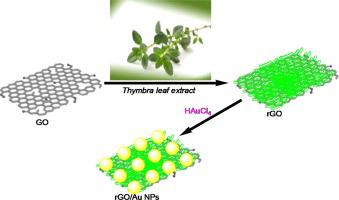Inorganic Chemistry Communications ( IF 4.4 ) Pub Date : 2021-09-15 , DOI: 10.1016/j.inoche.2021.108918 Haixia Liu 1 , Wei Shi 1 , Yi Luo 2 , Guozhong Cui 3 , Xiangjun Kong 4 , Lijie Han 5 , Lianli Zhao 1

|
An efficient and green approach described for reduced graphene oxide-Au nanoparticles hybrid by using extract of Thymbra as stabilizing/reducing agent. Thyme extract can reduce graphene oxide and immobilized on its surface. Next, the modified surface did reduce Au ions to Au nanoparticles and stabilize them. The resulting rGO/Au NPs nanocomposite were characterized by various technique like UV–Vis spectroscopy, field emission scanning electron microscopy (FE-SEM), energy dispersive X-ray spectroscopy (EDS), wavelength-dispersive X-ray spectroscopy (WDX), X-ray diffraction (XRD), transmission electron microscopy (TEM) and inductively coupled plasma (ICP). The results showed that Au nanoparticles uniformly decorated on the surface of designed graphene. In the cellular and molecular part of the recent study, the treated cells with rGO/Au NPs nanocomposite were assessed by MTT assay for 48 h about the cytotoxicity and anti-human breast cancer properties on normal (HUVEC) and breast malignancy cell lines i.e., breast adenocarcinoma (MCF7), breast carcinoma (Hs 578Bst), infiltrating ductal cell carcinoma (Hs 319.T), and metastatic carcinoma (MDA-MB-453). The viability of malignant breast cell line reduced dose-dependently in the presence of rGO/Au NPs nanocomposite. The IC50 of rGO/Au NPs nanocomposite were 186, 308, 125, and 403 µg/mL against Hs 578Bst, MCF7, Hs 319.T, and MDA-MB-453 cell lines, respectively. In the antioxidant test, the IC50 of rGO/Au NPs nanocomposite and BHT against DPPH free radicals were 125 and 165 µg/mL, respectively.
中文翻译:

Au纳米颗粒在还原氧化石墨烯上的绿色支持:其细胞毒性、抗氧化和抗人类乳腺癌特性的研究
通过使用Thymbra提取物作为稳定/还原剂,描述了一种用于还原氧化石墨烯 - 金纳米颗粒杂化的高效绿色方法。百里香提取物可以还原氧化石墨烯并固定在其表面。接下来,改性表面确实将 Au 离子还原为 Au 纳米颗粒并稳定它们。所得的 rGO/Au NPs 纳米复合材料通过各种技术进行表征,如紫外-可见光谱、场发射扫描电子显微镜 (FE-SEM)、能量色散 X 射线光谱 (EDS)、波长色散 X 射线光谱 (WDX)、 X 射线衍射 (XRD)、透射电子显微镜 (TEM) 和电感耦合等离子体 (ICP)。结果表明,Au纳米颗粒均匀地装饰在设计的石墨烯表面。在最近研究的细胞和分子部分,用 rGO/Au NPs 纳米复合材料处理的细胞通过 MTT 测定法评估了 48 小时关于正常 (HUVEC) 和乳腺恶性肿瘤细胞系 i 的细胞毒性和抗人乳腺癌特性。例如,乳腺腺癌 (MCF7)、乳腺癌 (Hs 578Bst)、浸润性导管细胞癌 (Hs 319.T) 和转移癌 (MDA-MB-453)。在 rGO/Au NPs 纳米复合材料的存在下,恶性乳腺细胞系的活力呈剂量依赖性降低。rGO/Au NPs 纳米复合材料对 Hs 578Bst、MCF7、Hs 319.T 和 MDA-MB-453 细胞系的 IC50 分别为 186、308、125 和 403 µg/mL。在抗氧化测试中,rGO/Au NPs 纳米复合材料和 BHT 对 DPPH 自由基的 IC50 分别为 125 和 165 µg/mL。对 Hs 578Bst、MCF7、Hs 319.T 和 MDA-MB-453 细胞系的浓度分别为 125 和 403 µg/mL。在抗氧化测试中,rGO/Au NPs 纳米复合材料和 BHT 对 DPPH 自由基的 IC50 分别为 125 和 165 µg/mL。对 Hs 578Bst、MCF7、Hs 319.T 和 MDA-MB-453 细胞系的浓度分别为 125 和 403 µg/mL。在抗氧化测试中,rGO/Au NPs 纳米复合材料和 BHT 对 DPPH 自由基的 IC50 分别为 125 和 165 µg/mL。











































 京公网安备 11010802027423号
京公网安备 11010802027423号